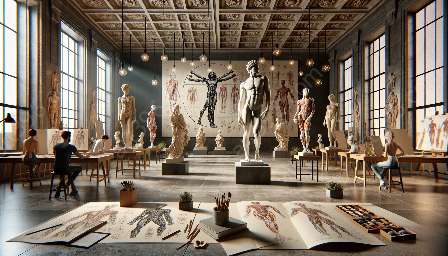Dynamic anatomy plays a crucial role in visual art and is instrumental in creating realistic and expressive figures. The perception of dynamic anatomy is deeply rooted in psychological principles, providing a fascinating blend of art and science. Understanding the psychological aspects of how we perceive dynamic anatomy can greatly benefit artists, students of artistic anatomy, and anyone interested in the interplay between the mind and visual art.
1. The Role of Gestalt Principles
The Gestalt principles of perception, such as figure-ground relationship, similarity, and closure, greatly influence how we perceive dynamic anatomy in visual art. For example, the figure-ground principle helps viewers distinguish the human figure from the surrounding environment, while the principles of similarity and closure aid in organizing and interpreting complex anatomical details.
2. Perception of Movement and Pose
Our perception of dynamic anatomy is also influenced by how the brain processes movement and pose. Through years of evolution, humans have developed a keen ability to detect and interpret movement, which directly impacts our perception of dynamic anatomical forms in art. Artists leverage this understanding by employing techniques that convey a sense of movement and pose, capturing the essence of dynamic anatomy.
3. Emotional and Cognitive Impact
Dynamic anatomy in visual art often evokes strong emotional and cognitive responses. The portrayal of dynamic anatomy can communicate a wide range of emotions, from power and grace to vulnerability and tension. Understanding the psychological underpinnings of these emotional and cognitive reactions enables artists to create captivating and evocative representations of dynamic anatomy.
4. Visual Processing and Attention
The way our visual system processes and directs attention within a scene greatly influences how we perceive dynamic anatomy. Artists strategically manipulate visual elements, such as color, line, and composition, to direct the viewer's attention towards key anatomical features, enhancing the perception of dynamic anatomy and guiding the interpretation of the artwork.
5. Cross-modal Perception
Dynamic anatomy engages cross-modal perception, where visual cues interact with our tactile, kinesthetic, and proprioceptive senses. This multidimensional perception enriches the experience of viewing and creating dynamic anatomical art, as the integration of various sensory inputs adds depth and realism to the depiction of dynamic anatomy.
6. The Artist's Perspective
Artists themselves play a pivotal role in shaping the perception of dynamic anatomy. Their understanding of psychological principles, combined with technical proficiency in artistic anatomy, empowers them to craft compelling and resonant portrayals of dynamic anatomy. By embracing the interplay of psychology and art, artists can harness the full potential of dynamic anatomy to communicate narratives and evoke profound emotional responses.
Conclusion
The perception of dynamic anatomy in visual art is a multifaceted phenomenon that intertwines psychological principles with artistic anatomy. By delving into the psychological underpinnings of dynamic anatomy, artists and students of artistic anatomy gain a deeper appreciation for the intricate interplay between the mind and visual representation. This holistic understanding fosters the creation of art that captivates, informs, and profoundly resonates with viewers across diverse cultural and cognitive landscapes.

